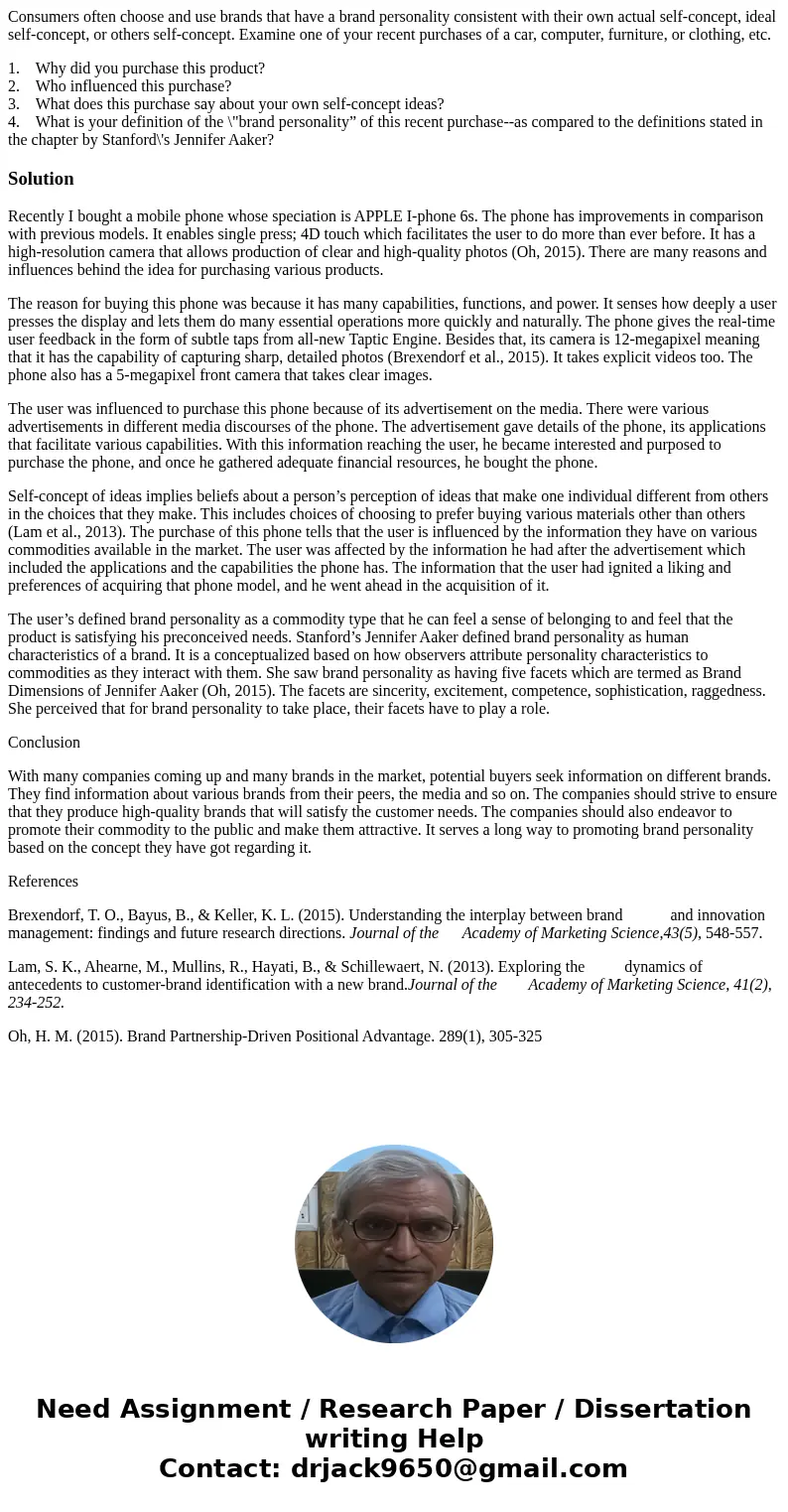Consumers often choose and use brands that have a brand pers
Consumers often choose and use brands that have a brand personality consistent with their own actual self-concept, ideal self-concept, or others self-concept. Examine one of your recent purchases of a car, computer, furniture, or clothing, etc.
1. Why did you purchase this product?
2. Who influenced this purchase?
3. What does this purchase say about your own self-concept ideas?
4. What is your definition of the \"brand personality” of this recent purchase--as compared to the definitions stated in the chapter by Stanford\'s Jennifer Aaker?
Solution
Recently I bought a mobile phone whose speciation is APPLE I-phone 6s. The phone has improvements in comparison with previous models. It enables single press; 4D touch which facilitates the user to do more than ever before. It has a high-resolution camera that allows production of clear and high-quality photos (Oh, 2015). There are many reasons and influences behind the idea for purchasing various products.
The reason for buying this phone was because it has many capabilities, functions, and power. It senses how deeply a user presses the display and lets them do many essential operations more quickly and naturally. The phone gives the real-time user feedback in the form of subtle taps from all-new Taptic Engine. Besides that, its camera is 12-megapixel meaning that it has the capability of capturing sharp, detailed photos (Brexendorf et al., 2015). It takes explicit videos too. The phone also has a 5-megapixel front camera that takes clear images.
The user was influenced to purchase this phone because of its advertisement on the media. There were various advertisements in different media discourses of the phone. The advertisement gave details of the phone, its applications that facilitate various capabilities. With this information reaching the user, he became interested and purposed to purchase the phone, and once he gathered adequate financial resources, he bought the phone.
Self-concept of ideas implies beliefs about a person’s perception of ideas that make one individual different from others in the choices that they make. This includes choices of choosing to prefer buying various materials other than others (Lam et al., 2013). The purchase of this phone tells that the user is influenced by the information they have on various commodities available in the market. The user was affected by the information he had after the advertisement which included the applications and the capabilities the phone has. The information that the user had ignited a liking and preferences of acquiring that phone model, and he went ahead in the acquisition of it.
The user’s defined brand personality as a commodity type that he can feel a sense of belonging to and feel that the product is satisfying his preconceived needs. Stanford’s Jennifer Aaker defined brand personality as human characteristics of a brand. It is a conceptualized based on how observers attribute personality characteristics to commodities as they interact with them. She saw brand personality as having five facets which are termed as Brand Dimensions of Jennifer Aaker (Oh, 2015). The facets are sincerity, excitement, competence, sophistication, raggedness. She perceived that for brand personality to take place, their facets have to play a role.
Conclusion
With many companies coming up and many brands in the market, potential buyers seek information on different brands. They find information about various brands from their peers, the media and so on. The companies should strive to ensure that they produce high-quality brands that will satisfy the customer needs. The companies should also endeavor to promote their commodity to the public and make them attractive. It serves a long way to promoting brand personality based on the concept they have got regarding it.
References
Brexendorf, T. O., Bayus, B., & Keller, K. L. (2015). Understanding the interplay between brand and innovation management: findings and future research directions. Journal of the Academy of Marketing Science,43(5), 548-557.
Lam, S. K., Ahearne, M., Mullins, R., Hayati, B., & Schillewaert, N. (2013). Exploring the dynamics of antecedents to customer-brand identification with a new brand.Journal of the Academy of Marketing Science, 41(2), 234-252.
Oh, H. M. (2015). Brand Partnership-Driven Positional Advantage. 289(1), 305-325

 Homework Sourse
Homework Sourse